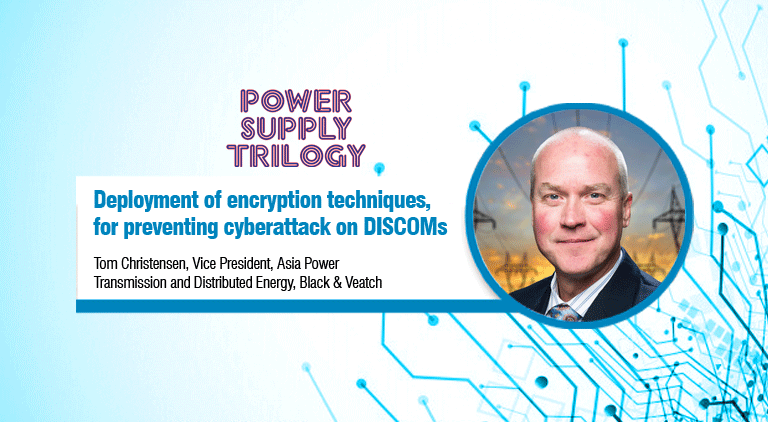Deployment of encryption techniques, for preventing cyberattack on DISCOMs
By EPR Magazine Editorial November 18, 2019 12:43 pm IST
By EPR Magazine Editorial November 18, 2019 12:43 pm IST

Discussing various aspects where DISCOMS and GENCOS should work upon, Tom Christensen, Vice President, Asia Power Transmission and Distributed Energy, Black & Veatch and Sachin Deole, Director, Business Development – Power, India Black & Veatch says having a smart distribution management system that enables a smooth integration of energy systems can help meet supply demands.
Moving away from power generation and focusing on supply. Your take?
Tom Christensen: It’s not a matter of one or the other; we need to develop both in an integrated manner. The country generates surplus power, but we still have communities suffering from intermittent power outages. So, we need the physical distribution network to deliver reliable power to all; in India, this means a mix of traditional and distributed generation technologies. We also need a financial and regulatory ecosystem that allows DISCOMS to deliver upon their commitments to customers and the GENCOs.
On the generation side, although we have surplus electricity now, demand for power is only going to increase. BP predicts our primary energy consumption will expand by 1.2 billion tonnes of oil equivalent or 156 per cent by 2040. So, along with modernising the distribution sector, we need to significantly increase the generation capacity to meet demand. The key is aligning the development of both at a strategic and delivery level.
What policy or tariff changes are you expecting to come under the UDAY 2.0 as it is supposedly aimed at improving operations?
Sachin Deole: Moody’s 2017 upgrade in the outlook for India’s power sector from negative to stable, was to a large degree based upon optimism about the ability of UDAY to improve the financial stability and operational performance of state DISCOMS. This should give confidence in the potential of UDAY 2.0. It looks as though UDAY 2.0 is offering more sticks than carrots to encourage the DISCOMS to improve their performance; and there is a long way to go. According to the PRAAPTI portal, the DISCOMS owed GENCOS ` 78,564 crores, as of August 2019. Introducing the mandatory letters of credit for getting supply from GENCOS should help ease the availability of power, but does less to influence the underlying economic fundamentals.
UDAY 2.0 proposes DISCOMS to pay a surcharge for delayed payment which is equivalent to the commercial rate of interest; as well as restricting poorly performing DISCOMS’ access to national government finance. These look like strong incentives for the DISCOMS to enhance performance. The absence of long-term power purchase agreements that should help ensure stability between supply and demand, however, remains a challenge.
Despite no publicly declared major incidents of cyber attack in the renewable energy sector to date, successful attacks on the wider energy industry are expected. What are your thoughts on how to curb off such attacks?
Sachin Deole: Incorporating greater levels of grid automisation, and smart technologies brings the potential for cybercrime. As efficiency and modernisation drive the convergence of information technology (IT) and operational technology (OT), hackers can gain access to the OT infrastructure via an IT system. Mitigating against this requires a fundamental shift in approach to security where security was once set up under IT only or as a separate shop, it needs to become integrated into a broader IT/OT function.
While prosecuting cybercrime is not within the remit of the power sector, there is a great deal that the industry can do to protect itself. Potential actions such as upgrades in network access control, firewalls and intrusion-detection systems are among the quickest wins; with the deployment of encryption techniques a logical next step.
Addressing shortcomings in core assets may be the quickest, easiest response and can more easily leverage in-house resource capabilities because of its relatively small scale. Edge assets such as switches, regulators and capacitor banks and backhaul can be more difficult to protect; given the larger scale and the fact that many infrastructure assets were designed and built years ago without security in mind and at a time when the prevalence of analogue systemsbrought security through technological obscurity.
What kind of transmission infrastructure should be in place for an efficient supply?Moving away from large urban centers we will see more distributed energy systems. Hybrid systems combining multiple sources of renewable energy with smart distribution technology have great potential. Core components of a typical hybrid system might include a small utility-scale solar array, and small utility-scale wind array, coupled to an optimised battery storage system.
Hybrid systems allow surplus power generated when the sun shines and the wind blows to be captured and then distributed when demand peaks; or when conditions are unsuitable for solar or wind generation. A hybrid plant’s advanced powermanagement system will assist the distribution company in efficient grid management through real-time monitoring of ramps, peak shifting and matching of load and generation profiles.
In the most remote locations onsite generation through rooftop solar is likely to be the power source of choice in the short to medium term. This may change over time as grid coverage extends and the cost of ‘last-mile’ connection to remote communities starts to decrease.
We need a financial and regulatory ecosystem that allows DISCOMS to deliver upon their commitments to customers and the GENCOs.
Tom Christensen, Vice President, Asia Power Transmission and Distributed Energy,
Black & Veatch
The absence of long-term power purchase agreements that should help ensure stability between supply and demand remains a challenge.
Sachin Deole, Director, Business Development – Power, India,
Black & Veatch
We use cookies to personalize your experience. By continuing to visit this website you agree to our Terms & Conditions, Privacy Policy and Cookie Policy.